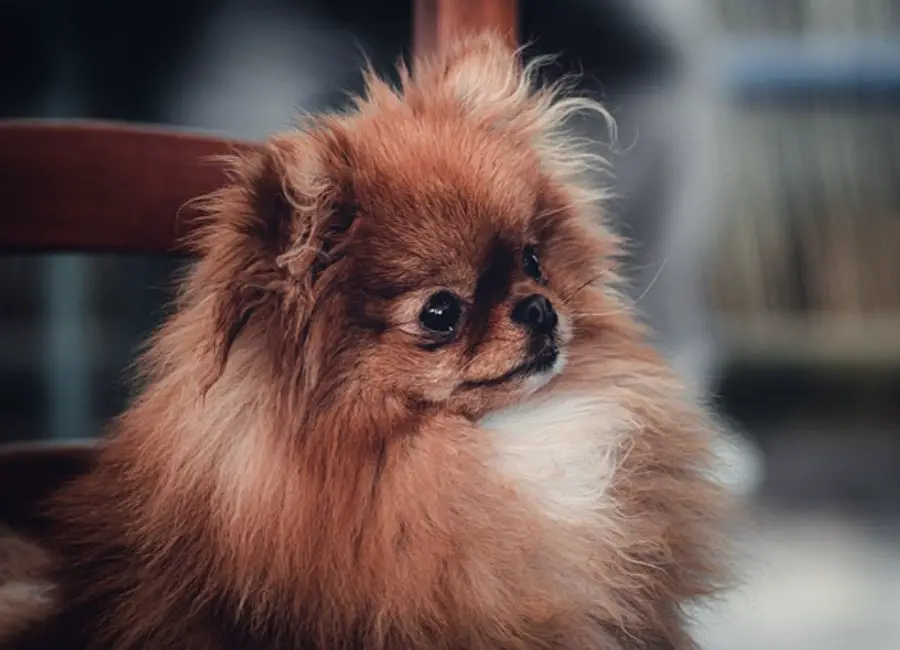25 Most Common Pekingese Behavior

Hey, there Pekingese lovers! Do you have a Pekingese pooch or thinking about getting one?
These cute little canines have quite the reputation for their quirky and sometimes peculiar behavior.
From snorting and snuffling to being fiercely loyal and protective, Pekingese pups are a unique breed that always keeps us on our toes.
In this blog post, we’ll take a closer look at some of these fascinating behaviors, so you can better understand your furry friend and deepen your bond with them.
Ready to learn more? Let’s jump right in!
Pekingese Behavior
The followings are some common and simple Pekingese behavior and their meanings:
1. Barking at Strangers
Pekingese dogs have a strong protective instinct, which manifests itself in their predisposition to bark at strangers or new sounds.
They bark to warn you of potential intruders or strange conditions.
While acknowledging their awareness is crucial, providing comfort and adequate training can help them feel more confident in their surroundings.
2. Snoring
There’s no need to be concerned if you’ve ever heard your Pekingese snore. This is a common and expected occurrence in these dogs.
Pekingese are more prone to snoring due to their distinctive face structure and pushed-in nose.
When they snore, it usually means they are in a deep, contented sleep, entirely relaxed in their surroundings.
3. Tilting Their Head
The charming head tilt is a typical Pekingese canine behavior that frequently melts hearts.
They tilt their heads for a variety of reasons. For starters, it enables kids to better focus on sounds and commands, displaying their attentiveness and enthusiasm to comprehend.
Furthermore, it demonstrates their interest and participation in the discussion, making them even more endearing to their human friends.
4. Tail Curled Over the Back
When a Pekingese carries their tail curled over their back, it shows their confidence and regal attitude.
This trait is strongly ingrained in their past as Chinese royal companions.
They express confidence and assert their presence in their surroundings by carrying their tail in this fashion.
5. Licking Your Face
Pekingese dogs are known for their friendly disposition, and licking your face shows their love and trust.
It’s their way of bonding with you and demonstrating their love.
They are not only distributing their scent when they lick your face, but they are also mimicking grooming, which is a social bonding practice among dogs.
6. Growling with a Wagging Tail
While growling is commonly linked with violence, it can also be a sign of joy or fun in a Pekingese.
When they growl while wagging their tail, it usually means they are looking forward to something fun, such as interactive playtime or a favorite activity.
7. Snorting and Snuffling
Pekingese dogs’ adorable snorting and snuffling sounds are part of their distinct appeal.
These responses are common when they encounter new odors or items.
They actively explore and investigate their environment by snorting and snuffling, relying primarily on their strong sense of smell.
8. Rolling on Their Back
A Pekingese rolling onto their back is a sign of submission and trust. They are demonstrating that they feel safe and secure in your presence by exposing their sensitive belly.
This behavior invites you to engage in a nice belly rub or play session, which can enhance your bond with your furry buddy.
9. Pawing
Pawing is one of the communication tactics employed by Pekingese dogs.
When they paw at you, it can be an indication that they are seeking attention, affection, or playtime.
By using their paws, they are actively reaching out to connect with you and express their needs or desires.
10. Grumbling
Pekingese dogs have a particular low, grumble whine that they utilize to indicate a wide range of emotions.
It can indicate minor displeasure, contentment, or even satisfaction following a meal.
This activity helps people to express their emotions and needs verbally, providing significant insights into their current state of mind.
11. Avoiding Eye Contact
While Pekingese dogs are normally friendly, they may avoid direct eye contact at times.
This behavior may imply timidity or submissiveness. It is critical to respect their boundaries and provide them with the space they require.
Allow people to approach you on their own terms, when they are ready to engage.
12. Pacing
Pacing back and forth may suggest restlessness or worry in your Pekingese.
Various reasons, including as changes in their surroundings or routine, can cause this behavior.
Identify any potential stressors and offer a peaceful and comfortable area for them to relax to assist lessen their anxiety.
Offering reassurance and engaging them in soothing activities can also help.
13. Gazing Out the Window
Pekingese dogs are frequently observed perched near windows, staring out with interest.
This behavior satisfies their curious nature while also stimulating their minds.
They can engage their senses and fulfill their natural inclination to be aware of their surroundings by observing the world outside their local surroundings.
14. Yawning
Pekingese dogs yawn not only to relieve fatigue but also to relieve stress or tension.
If you notice your pet yawning frequently, it could be an indication that they require some quiet time and relaxation.
Yawning allows them to relax and reset, helping them to achieve a state of peace and equilibrium.
15. Paw Lifting
A Pekingese elevating their paw is a graceful manner of demanding attention or affection.
This behavior is frequently displayed when they want to be acknowledged or pampered.
Accept their polite plea and reply with loving gestures. Recognize their need for affection and give them the attention they crave.
16. Play Bows
When a Pekingese enters the playful bow stance with their front end down and hindquarters up, it’s an unmistakable invitation to play.
This action serves as an invitation to play and indicates that they are ready for a fun frolic.
Respond in kind and have fun together, deepening your friendship through shared activities.
17. Cuddling or Leaning
Pekingese are recognized for their friendly temperament, and their proclivity to cuddle or rest against their loved ones emphasizes this trait.
This conduct represents their need for physical proximity and acts as a reminder of their steadfast loyalty.
Cherish these intimate times and return their warmth to enhance your friendship.
18. Nibbling or Chewing
Pekingese are famous for their proclivity to nibble or gnaw on numerous objects.
This behavior can function as a form of exploration, teething alleviation, or even to mark their territory.
Providing appropriate chew toys and refocusing their attention can aid in the reduction of destructive tendencies.
To keep kids occupied and satisfied, channel their chewing inclinations into appropriate outlets.
19. Sleeping on Their Back
Spotting your Pekingese snoozing on their back with all paws in the air is a sign of trust and vulnerability.
This conduct shows their entire comfort in their surroundings as well as their complete dependence on you to keep them safe.
Respect their fragility and provide a supportive setting in which they can feel safe.
20. Side-Eye Glances
Have you ever caught your Pekingese giving you a sideways glance? This behavior typically suggests wariness or mild suspicion.
They may be assessing their surroundings or sizing up new people or situations.
It’s their subtle way of letting you know that caution is in order. Respect their intuition and provide them with a sense of security.
21. Prancing or High Stepping
Pekingese dogs have a distinctive gait characterized by prancing or high stepping.
This behavior is often seen when they are excited or enthusiastic about something.
It’s their way of showcasing their joyful energy and adding an extra touch of elegance to their movements.
22. Nudging or Pawing at Food
When a Pekingese nudges or paws at their food bowl, it can indicate a couple of things.
They may be expressing their eagerness and anticipation for mealtime or signaling that they are not satisfied with the current food portion.
Pay attention to their cues and ensure they are getting the appropriate amount of nourishment.
23. Scratching or Digging
Pekingese dogs have a natural instinct to scratch or dig at the ground, blankets, or furniture.
This behavior is often a way for them to create a comfortable spot to rest or mark their territory.
Provide them with appropriate outlets for this behavior, such as a designated scratching post or a cozy bed they can dig into.
Learn more about Pekingese aggressive behavior.
24. Jumping
Pekingese dogs may have a tendency to jump up on people or furniture. This behavior can be driven by their curiosity, desire for attention, or excitement.
Consistent training and redirecting their energy toward appropriate outlets, such as teaching them to sit or offering interactive toys, can help discourage excessive jumping.
25. Tail Tucked Between Legs
If you notice your Pekingese tucking their tail between their legs, it usually indicates fear, anxiety, or submission.
This behavior can occur in response to loud noises, unfamiliar situations, or stressful environments.
Provide a calm and secure space, and offer reassurance to help them feel safe and gradually overcome their fears.
Learn more about socializing your Pekingese.
Conclusion
In conclusion, Pekingese dogs are a breed that is full of character, and their unique behaviors make them a popular choice for dog owners worldwide.
Whether it’s their regal demeanor, playful nature, or stubborn streak, Pekingese dogs always keep us on our toes.
By understanding their behavior and needs, we can form a strong bond with our furry companions that lasts a lifetime.
So, embrace the quirks of your Pekingese, and enjoy all the love and joy they bring to your life!
